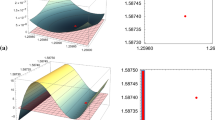Abstract
In the 3SUM problem we are given three lists \(\mathcal {A}\), \(\mathcal {B}\), \(\mathcal {C}\), of n real numbers, and are asked to find \((a,b,c)\in \mathcal {A}\times \mathcal {B}\times \mathcal {C}\) such that \(a+b=c\). The longstanding 3SUM conjecture—that 3SUM could not be solved in subquadratic time—was recently refuted by Grønlund and Pettie. They presented \(\hbox {O}\left( n^2(\log \log n)^{\alpha }/(\log n)^{\beta }\right) \) algorithms for 3SUM and for the related problems Convolution3SUM and ZeroTriangle, where \(\alpha \) and \(\beta \) are constants that depend on the problem and whether the algorithm is deterministic or randomized (and for ZeroTriangle the main factor is \(n^3\) rather than \(n^2\)). We simplify Grønlund and Pettie’s algorithms and obtain better bounds, namely, \(\alpha =\beta =1\), deterministically. For 3SUM our bound is better than both the deterministic and the randomized bounds of Grønlund and Pettie. For the other problems our bounds are better than their deterministic bounds, and match their randomized bounds.



Similar content being viewed by others
Notes
Although randomized algorithms are often significantly simpler than their deterministic counterparts, this is not the case here. Grønlund and Pettie’s randomized algorithms are in fact more complicated than our (and their) deterministic ones, and thus offer no advantage.
Throughout this paper we follow the convention that array indexing starts at 1 (as opposed to 0, which is the convention followed by a number of popular programming languages).
Cautionary remark to readers familiar with Grønlund and Pettie [8]: they use the standard matrix indexing scheme, in which square (i, j) is in the ith row from the top and the jth column from the left. Also, they associate A with the vertical axis and B with the horizontal one.
Note that the vector components are actual numbers that we can compute, since we now have A and B.
References
Ailon, N., Chazelle, B.: Lower bounds for linear degeneracy testing. J. ACM 52(2), 157–171 (2005)
Baran, I., Demaine, E.D., Pǎtraşcu, M.: Subquadratic algorithms for 3SUM. Algorithmica 50(4), 584–596 (2008)
Butman, A., Clifford, P., Clifford, R., Jalsenius, M., Lewenstein, N., Porat, B., Porat, E., Sach, B.: Pattern matching under polynomial transformation. SIAM J. Comput. 42(2), 611–633 (2013)
Chan, T.M.: All-pairs shortest paths with real weights in \(\text{ O }(n^3/\log n)\) time. Algorithmica 50(2), 236–243 (2008)
Chan, T.M.: Speeding up the four Russians algorithm by about one more logarithmic factor. In: Proceedings of the 26th Annual ACM-SIAM Symposium on Discrete Algorithms, pp. 212–217. Society for Industrial and Applied Mathematics, Philadelphia (2015)
Erickson, J.: Lower bounds for linear satisfiability problems. Chic. J. Theor. Comput. Sci. 8, 388–395 (1997)
Gajentaan, A., Overmars, M.H.: On a class of \(\text{ O }(n^2)\) problems in computational geometry. Comput. Geom. 5(3), 165–185 (1995)
Grønlund, A., Pettie, S.: Threesomes, degenerates, and love triangles. In: Proceedings of the 55th IEEE Symposium on Foundations of Computer Science. ArXiv preprint arXiv:1404.0799 (2014)
Impagliazzo, R., Lovett, S., Paturi, R., Schneider, S.: 0–1 Integer linear programming with a linear number of constraints. ArXiv preprint arXiv:1401.5512 (2014)
Pǎtraşcu, M.: Towards polynomial lower bounds for dynamic problems. In: Proceedings of the Forty-Second ACM Symposium on Theory of Computing, pp. 603–610. Association for Computing Machinery, New York (2010)
Preparata, F.P., Shamos, M.I.: Computational Geometry, an Introduction. Springer, New York (1985)
Acknowledgments
The author is grateful to the anonymous reviewers (especially “Reviewer #1”) for helpful suggestions on improving the presentation.
Author information
Authors and Affiliations
Corresponding author
Rights and permissions
About this article
Cite this article
Freund, A. Improved Subquadratic 3SUM. Algorithmica 77, 440–458 (2017). https://doi.org/10.1007/s00453-015-0079-6
Received:
Accepted:
Published:
Issue Date:
DOI: https://doi.org/10.1007/s00453-015-0079-6




